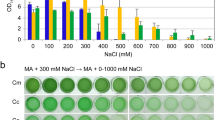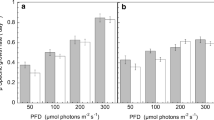Abstract
Currently, blue-green algae are classified as either freshwater or marine depending on the ionic requirements of the strain, not on the type of habitat from which the strain was isolated. As a result many strains isolated from saline environments are classified as freshwater strains. New parameters were sought which might correlate better the physiology of marine strains with their habitat. This study reveals that blue-green algae isolated from the marine environment have a unique osmoregulatory system which distinguishes them as a coherent physiological group, distinct from blue-green algae isolated from non-marine habitats. The “marine” blue-green algae can be identified by their ability to synthesise and accumulate 2-O-α-D-glucopyranosylglycerol (glucosylglycerol), a major osmoregulatory compound, and by their related ability to grow in seawater-based medium with total maximum NaCl of 6 to 11% (w/v). These two properties allow a more rigorous definition of “marine” than the current method of classification.
Similar content being viewed by others
Literature Cited
Borowitzka, L. J., S. Demmerle, M. A. Mackay and R. S. Norton: Carbon-13 nuclear magnetic resonance study of osmoregulation in a blue-green alga. Science N.Y. 210, 650–651 (1980)
Brown, A. D.: Microbial water stress. Bact. Rev. 40, 803–846 (1976)
Caldwell, D. R. and R. F. Hudson: Sodium, an obligate growth requirement for predominant rumen bacteria. Appl. Microbiol. 27, 549–552 (1974)
Craigie, J. S.: Storage products. In: Algal physiology and biochemistry, pp 206–235. Ed. by W. D. P. Stewart. Oxford: Blackwell Scientific 1974
Geitler, L.: Cyanophyceae. In: Kryptogamenflora von Deutschland Österreich und der Schweïz, Vol. 14. pp. 1–1196. Ed. by R. Kolkwitz. Leipzig: Akademische Verlagsgesellschaft 1932
Golubic, S.: Halophily and halotolerance in cyanophytes. Origins of Life 10, 169–183 (1980). (Dordrecht, Holland, and Boston, USA: D. Reidel Publishing Co.)
Guillard, R. R. L.: Organic sources of nitrogen for marine centric diatoms. In: Symposium on marine microbiology, pp 93–104. Ed. by C. H. Oppenheimer. Springfield, Illinois: Charles Thomas 1963
Johnson, P. W. and J. McN. Sieburth: Chroococcoid cyanobacteria in the sea: a ubiquitous and diverse phototrophic biomass. Limnol. Oceanogr. 24, 928–935 (1979)
Kuhl, D. L. and L. C. Oglesby: Reproduction and survival of the pileworm Nereis succinea in higher Salton Sea salinities. Biol. Bull. mar. biol. Lab., Woods Hole 157, 153–165 (1979)
Ragan, M. A. and D. J. Chapman: A biochemical phylogeny of the protists, 317 pp. New York: Academic Press 1978
Reichelt, J. L. and P. Baumann: Effect of sodium chloride on growth of heterotrophic marine bacteria. Archs Microbiol. 97, 329–345 (1974)
Rippka, R., J. Deruelles, J. B. Waterbury, M. Herdman and R. Y. Stanier: Generic assignments, strain histories and properties of pure cultures of cyanobacteria. J. gen. Microbiol. 111, 1–61 (1979)
Stam, W. T.: Relationships between a number of filamentous blue-green algal strains (Cyanophyceae) revealed by DNA-DNA hybridization. Arch. Hydrobiol. (Suppl.) 56, 351–374 (1980)
Stam, W. T. and H. C. Holleman: The influence of different salinities on growth and morphological variability of a number of Phormidium strains (Cyanophyceae) in culture. Acta bot. neerl. 24, 379–390 (1975)
Stanier, R. Y. and G. Cohen-Bazine: Phototrophic prokaryotes: the cyanobacteria. A. Rev. Microbiol. 31, 225–274 (1977)
Stanier, R. Y., R. Kunisawa, M. Mandel and G. Cohen-Bazire: Purification and properties of unicellular blue-green algae (order Chroococcales). Bact. Rev. 35, 171–205 (1971)
Waterbury, J. B.: Purification and properties of some freshwater and marine cyanobacteria belonging to the orders Chamaesiphonales and Pleurocapsales, 279 pp. PhD dissertation, University of California, Berkeley 1976
Waterbury, J. B., S. W. Watson, R. R. L. Guillard and L. E. Brand: Widespread occurrence of a unicellular, marine, planktonic cyanobacterium. Nature, Lond. 277, 293–294 (1979)
Williams, W. D.: Limnology of Victorian salt lakes, Australia. Verh. int. Verein. theor. angew. Limnol. 20, 1165–1174 (1978)
ZoBell, C.: Domain of the marine microbiologist. In: Symposium on marine microbiology, pp 3–24. Ed. by C. H. Oppenheimer. Springfield, Illinois: Charles Thomas 1963
Author information
Authors and Affiliations
Additional information
Communicated by G. F. Humphrey, Sydney
Rights and permissions
About this article
Cite this article
Mackay, M.A., Norton, R.S. & Borowitzka, L.J. Marine blue-green algae have a unique osmoregulatory system. Mar. Biol. 73, 301–307 (1983). https://doi.org/10.1007/BF00392256
Accepted:
Issue Date:
DOI: https://doi.org/10.1007/BF00392256




